Dora Wings 1/48 Vultee Vengeance Mk. II
The Airplane:
The V-72 Vengeance dive-bomber was developed independently by Vultee Aircraft Co. for France. A French purchasing commission led by Col Paul Jacquin contracted with Vultee, based on their experience with the V-11 family of attack bombers. The V-72 was a large two-seat aircraft powered by the Wright R-2600 Cyclone. France ordered 300 but fell before any were delivered.
The Vengeance was a two-seat, mid-wing, cantilever monoplane dive-bomber of all-metal, stressed-skin, semi-monocoque construction. It had an internal fuselage bomb bay, fully enclosed with longitudinally double-hinged and hydraulically operated bomb doors. Two bomb crutches swung the bombs clear of the propeller arc. Wing racks could also be fitted.
After the collapse of France, and due to pressure from Lord Beaverbrook, the UK's Ministry of Aircraft Production bypassed RAF requirements, taking over and extending French orders for the V-72.
The first V-72, first flew in July 1941, rather than at the end of March as often stated. There was no prototype and few changes were needed. The distinctive wing planform was the result of a miscalculation in the center of gravity, with the inner wing extended forward to deal with this, while the outer wings were given dihedral to increase stability. The wing had zero incidence, which allowed for good aim in a dive, but also resulted in the airplane flying in a significant nose-up in level flight which hindered pilot visibility.
The V-72 was named Vengeance by Vultee, not by the British. Britain placed orders for 200 from Vultee, to be built in a new factory in Nashville, Tennessee, and another 200 from Northrop Aircraft in Hawthorne, California. Due to minor equipment and servicing differences, confusingly, the Vultee machines were designated Mk.II and the Northrop examples as Mk.I. The first Northrop-built Vengeance flew November 30, 1941.
A US order for 200 was placed as part of the new Lend-Lease arrangement for British use, designated as the Mk.Ia or A-31-NO by Northrop). Vultee-built aircraft in a second run under Lend-Lease were designated as Mk.III, or A-31-VN.
Production was slow, with only 12 aircraft having been accepted as of March 10, 1942.
After the Pearl Harbor attack, the AAF requisitioned large numbers of types intended for foreign customers, including the A-31. Developed for the USAAF, the Vengeance became the A-35 (Lend-Lease Mk. IV) with six wing guns instead of four and the twin .30-caliber guns in the rear exchanged for a single M2 .50-caliber gun. A 1,700hp Wright R-2600-13 or -8 was fitted, giving a slight increase in power, with 831 built. Of 562 allocated to the RAF as the Vengeance IV, 104 were Series 1 aircraft with the -13 engine and 458 Series 2s with the -8 powerplant. Another 141 Vengeance IVs went to the Royal Australian Air Force. The majority of MkIVs were converted to target tugs.
Northrop completed production in November 1943, with the last from Vultee in May 1944. In July 1943, Maj Gen Davenport Johnson, the AAF's director of military requirements, declared the A-31 to be “a shining example of the waste of material, man-power, and time in the production of an airplane which this office has tried to eliminate for several months."
In Service, the Vengeance was a good dive-bomber - but senior officers didn't want to use it
The first RAF squadrons, 82 and 110 Squadrons, replaced their Blenheims with Vengeances in October 1942. Both stationed at Cholavararn, Madras Presidency, they undertook anti-submarine patrols over the Bay of Bengal until being deployed to front-line duties. Slow deliveries initially limited each unit to eight aircraft while they worked up at Quetta, Balochistan and Cholavararn.
After training, an average pilot in a vertical dive could drop two internally carried 5001b and two wing-mounted 2501b bombs within 250 yards; in operations, this improved to a CEP of 25 yards, close enough to give really close support to ground troops. Unlike a fighter-bomber, bombs dropped in this manner had sufficient penetration to blast any deep bunker.
110 Squadron's first mission was flown on March 19, 1943 against a Japanese headquarters at Htizwe, Burma. 45 and 82 Squadrons joined 110 Squadron in March 1943 as 168 Wing, developing close support techniques with the army.
Vengeances were heavily deployed in support of the second Arakan campaign during 1943-44. Formations of 12 “VDBs” — the nickname used locally by the units for “Vengeance dive-bombers” — attacked Japanese strongpoints from October 1943 onwards, escorted by Hawker Hurricanes.
The 2501b and 5001b general-purpose bombs were augmented by 5001b NITI (nose instantaneous, tail instantaneous) bombs fitted with an extension rod for maximum above-ground blast and fragmentation in the jungle. Vengeances also acted as pathfinders for Wellingtons dropping 4,0001b high-explosive bombs.
On the Arakan front 82 Squadron operated with 8 Squadron Indian Air Force. Compared with B-24s that achieved 50 per cent hits and B-25s that scored 70 per cent, the Vengeances consistently scored 100 per cent in attacks on Japanese bunkers.
As the Republic Thunderbolt became available, the Vengeance became surplus to requirements. The onset of the monsoon season also prevented high-altitude dive run-ins. 82 Squadron flew its final sorties on May 19, 1944, with 110 Squadron finishing on June 1. The last Vengeance operations over Burma were carried out by 84 Squadron on July 16 1944.
Fundamentally, the RAF high command was implacably opposed to the dive-bomber concept. Official accounts even suppressed unit successes because they did not fit with air force doctrine. Notably, the Chindits only allowed the Vengeance to be used in providing them close air support due to the accuracy of the attacks.
Australia ordered Brewster Bermudas and Curtiss A-25 Shrikes, but in an agreement with the British in October 1941 the RAAF took over 297 Vengeances from RAF orders instead. In May 1942 the first five were erected at Bankstown, New South Wales, assisted by Vultee staff, but desperate pleas for more went unfulfilled as the Americans diverted production to their own needs. Further examples did not arrive until April 1943, when the immediate threat of invasion had passed.
In August 1943, General George Kenney, commander of the Allied Air Forces in the South-West Pacific, requested a squadron of dive-bombers for use against pinpoint targets in the Huon Gulf area. The semi-trained No 24 Squadron was rushed to Dobodura without the normal infrastructure as it was expected to be a brief deployment. They arrived on September 2 and flew their debut combat mission on September 7, complicated by bad weather and difficulty finding their base. On September 18, 14 Vengeances joined a strike on Finschhafen to assist a landing by the Australian Army, and during September and October the type played a significant role in halting a major Japanese counterattack. However, operations were limited by equipment shortages. Some issues were due to the crews having only partly trained in non-tropical southern Australia. Finally, in December, the squadron operated against Japanese positions on New Britain and New Ireland ahead of the American landings in western New Britain.
No 10 Operational Group was created around the Vengeance-equipped attack component of 77 Wing to act as a mobile strike force supporting Allied ground units advancing on the Japanese. The wing consisted of three squadrons: 21, 23 and 24, with Vengeances, escorted by 78 Wing's Kittyhawks. 24 Squadron made its first strike on January 17, 1944, the two other units joining battle on February 18.
On February 19, 24 Squadron bombed the Japanese at Hansa Bay. This long-range operation required a refueling stop at Dumpu, a challenging prospect as each Vengeance was fully loaded with two 500lb bombs and two 250lb anti-personnel bombs. A major effort began on February 26 with 36 Vengeances — 12 from each squadron — attacking the airstrips at Alexishafen and Madang. The raids were repeated on the 28th with 33 Vengeances. After a break of a few days while they bombed Japanese retreat routes, the airstrips were again heavily attacked, and on March 8 they joined a combined operation against a Japanese camp 10 miles north of Alexishafen. After the landings at Hollandia, it was found the air effort had completely neutralized the Japanese bases there, with 500 Japanese aircraft destroyed on the ground.
Despite this success — and to the crews' surprise — the Vengeance squadrons were withdrawn at the end of March on the orders of MacArthur, after only 15 days operating in New Guinea. Eventually they were replaced in combat by RAAF Beaufighter, Boston and Beaufort squadrons.
Ultimately, as with the RAF and Indian Air Force, Australia's use of the Vengeance was never regarded by high command as more than an unwanted experiment, despite valiant work by the crews. It is notable that other types including obsolete Commonwealth Wirraways were instead in limited dive-bombing use to the war's end. The RAAF Vengeance squadrons were re-equipped with Liberators.
In USAAF service, the A-31 was promoted in propaganda during exercises. The nearest A-31s and A-35s got to combat was training attack squadron pilots before they converted to P-47s. Otherwise they were used as target towing, a number of them flown by Women's Airforce Service Pilots (WASPs).
Capt Eric ‘Winkle' Brown stated of the Vengeance MkIV, “After the Ju 87, the Vengeance IV is the best dive bomber I have flown.”
One complete Vengeance Ia, A27-99 (previously EZ999 and never used in service), survives at the now private Camden Museum of Aviation in New South Wales, while components of Vengeance IIa A24-247 and others are held by the Illawarra-based Historical Aircraft Restoration Society as a possible future restoration project.
The Kit:
This Dora Wings Vengeance is the second to appear in 1/48, the first released several years ago by AZ Models. This kit is incomparably better than the earlier one, being fully accurate as well as being a better-designed kit. It comes in Dora Wings' tan plastic, with little if any flash. The kit is released as an RAAF Vengeance, with markings for the four squadrons that operated the type. The clear plastic canopy, which can only be assembled in the closed position, is very clear (interestingly, the aerodynamics of the Vengeance were such it was mostly flown with the canopies closed). Each example has interesting nose art.
One mistake is that the two machine guns supplied for the rear cockpit are .50-caliber rather than .30 caliber which was right for the Vengeance I and II.
Construction:
After watching another kit being assembled over at iModeler, I opted for a different method of construction.
I first assembled the wings. These are designed to have the flaps lowered, but they can be assembled “up” if the attachment points on the flaps are removed. I had thought to do the dive brakes extended, but when I saw how fragile the photoetch parts were, I opted to attach them closed, which was not hard.
The kit does not have a carry-through spar. However, if you assemble the wings to the relevant fuselge half before further fuselage assembly, you can get perfect fit without any filler needed. The wing is a solid assembly done this way. When I broke the horizontal stabilizer at the center point, I decided to attach those parts at this time also, which turned out to be a good idea since I was also able to get solid fit.
The control surfaces all have the now-standard Dora Wings molding of one half fitting inside the other in order to get a thin trailing edge, with a resulting seam that has to be filled and sanded smooth. Other than that, all the control surfaces fit easily in position.
I moved on to the cockpit, and assembled the cockpit and bomb bay before painting them. At this point I was going to have the bomb bay open, but after checking the attachment for the open doors, and the fact that the doors-closed part fit perfectly, I decided to go with the bomb bay closed up. I used Eduard seatbelts in the cockpit because I had them and they looked better than the kit's seatbelts.
The tailwheel assembly has to be done and installed before closing up the fuselage. Given its position at the extreme tail, I was sure it would be later broken and I was unsurprised when that happened. I managed to get the broken parts back in position, but the only solution here is to handle the rear fuselage with extreme caution once assembled.
The fuselage went together easily, though I did need to use Mr. Surface 500 on the centerline seams.
The engine was painted and assembled, and the engine cowling was also assembled. Again, I had a notable lack of success with the photo-etch cowling flaps and replaced those with flaps made from .010 Evergreen sheet.
Painting and Markings:
Vengeance was painted with US Lend-Lease colors: DuPont “flat Earth, which is a bit more yellow than the RAF official color, with US Medium Green in place of RAF Dark Green. (This might also have been US green-base OD-41, which is the same color as RAF Dark Green, the two colors both being based on the specifications for World War I “PC 10"). The lower surfaces were painted light grey. I did this with my “home-brew” Tamiya mix for US Dark Earth, based on Tamiya “Flat Earth” and “Khaki Drab,” and Tamiya “Deep Green” for the US Medium Green, and Tamiya “Sky Grey” for the light grey. Each color was “post shaded” to simulate sun fading.
As research, I had bought Peter Smith's “The Vultee Vengeance In Battle,” which is an excellent history of the type's use in the Burma campaign. I decided in the interests of “being different” to do a Vengeance as marked in 1943, with the standard RAF insignia with red colors, as an airplane of 110 Squadron. This was done with decals from the dungeon.
Final Finish and Assembly:
I applied some exhaust staining and “dings” on the airframe. I decided to arm the model with 250-lb bombs, using RAF bombs and racks from an Airfix Blenheim kit that I am not going to do with the bomb bay open. I attached the landing gear and prop and declared the project finished.
Overall:
The Vengeance will never be mistaken for anything else due to the unique airframe design. Modelers have long asked for a Vengeance in 1/48 scale and Dora Wings has delivered. I ordered mine shortly after the outbreak of the war in Ukraine, but it was delivered at the beginning of August. In the meantime, I had also gotten a kit from Scott Zuieback's “RebelAlpha” on eBay. I plan to do the second out OOB with the RAAF markings.
For those who have wanted a Vengeance in their collection, this is the kit you have waited for. Recommended for those with experience in limited-run kits.
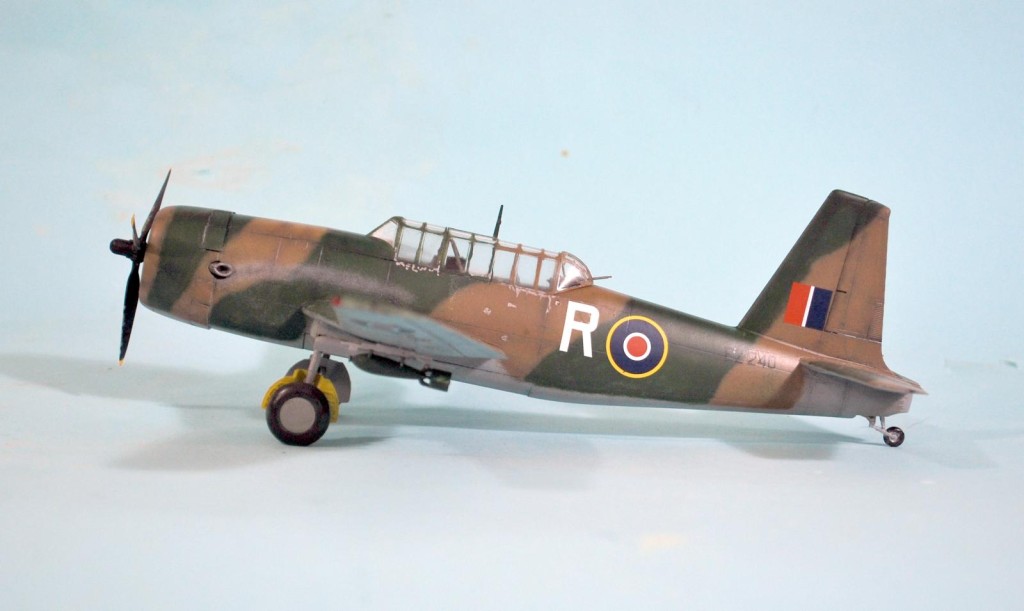
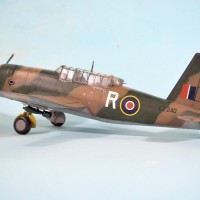
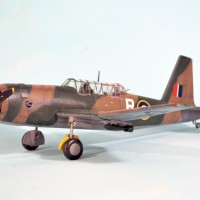
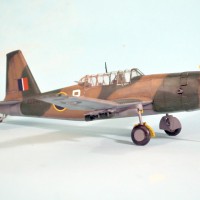
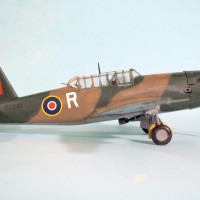
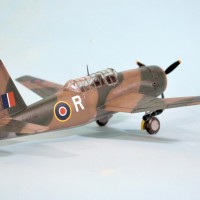
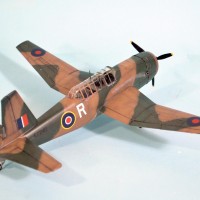
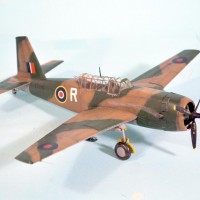
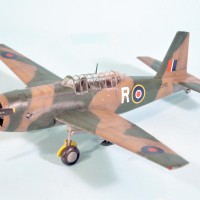
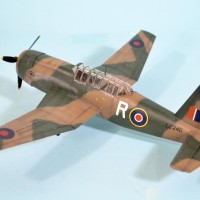
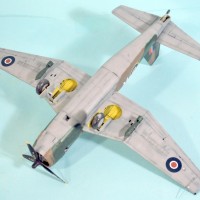
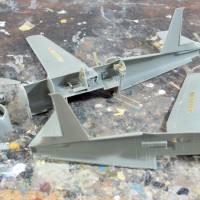


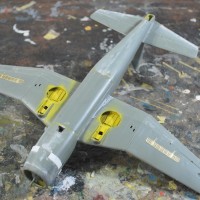
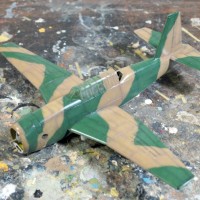
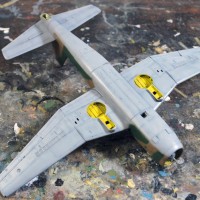
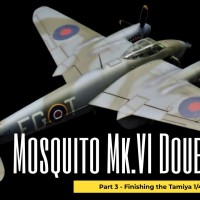
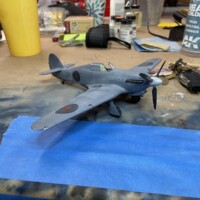


This build came out nicely, Tom (@tcinla). After your great build, I need to put the one I have in my stash into my build queue.
Excellent result, Tom! I got some .30 cals for the rear gunner’s position on mine and did some work on them today. I’m still determined open up that rear canopy.
@j-healy - If you have access to a vacuformer, vacuform the kit canopy.
Ack! More PE cowl flaps. More wing trailing edge seams. More fun from Dora, but I will tackle it. Always a fan of this unique and under appreciated airplane. My kid ordered 2, haven't seen them yet.
Your build turned out very well Sir. Vengeance is Yours.
Excellent result, Tom!
Another beautiful addition to your modelling collection, Tom @tcinla
Very nice scheme and great performed.
The historical article is very interesting.
Really nice work on this Tom. @tcinla I wonder if Dora is ever going to wake up and rethink the crappy photo etched cowl gills?
Tom, I like your Spitfires really well, but this Vengeance has its own charm that you have captured nicely. The photos with the unpainted and (partly) assembled model are also very instructive if one thinks to buy the kit, appreciated. KR G.M.
Nice job, Tom.
Nice kit and work of another Black Sheep of Aviation. Good planes and procurement are not always compatible
Did any serve in Europe at all ?
They were used by USAAF units as target tugs and hacks, also the RAF used some as target tugs.
Great post Tom- excellent all around on a unique subject. Thanks for sharing!
I like Your painting and weathering very much!
Great work on a very interesting subject, Tom. You don't see many of these built. I must confess I knew nothing about the Vengeance until I read your article. It turns out it was really a rather successful design, well-used and outstandingly accurate in the dive bombing role. Definitely a worthy subject and your model is painstakingly accurate and finely rendered as always. Thanks for the fascinating history lesson!
@coling - Old Hollywood rule: Flattery will get you everywhere! 🙂
Thank you.
Really cool subject and model. Really like the "trick" the angles of the wing play when taking a photo from the front vs. the photos from the back end. Think I've seen a picture of one of these with a four-bladed prop somewhere (prop synchronizer at the factory maybe?). Liked.
Very nice build and thanks for a lot of useful informations.
Is there an option to build canopy or bay open?
You can build the bomb bay open but you would have to vacuform the canopy to open it. fortunately, as I said, the Vengeance had its canopy closed most of the time, and the kit's clear parts are very clear, so you have no trouble seeing what's there to be seen.
Tom, @tcinla
This is a very informative article, and it reads very well. I also ordered one of these kits from the Ukraine way back in early April / late March. Then Scott had them listed on EBay, so not knowing if the one coming from the Ukraine would show up or not, I ordered a second kit from Scott aka "Rebelalpha". As luck would have it, the original one arrived about a month later coming in from the Ukraine.
So now I have two of these kit which is very cool. I want to build one as a plane from the US Army wearing the camouflage in British equivalent colors. The second kit will be done likely using the decals included in the box. There are some very cool pictures of the Nashville assembly line that are very interesting, with some being in color.
Thanks for the detailed assembly instructions. I will be using them when the time comes, (hopefully soon).
The Vengeance has a special meaning to me. My Dad bought me a Comet balsa wood model for my 9th birthday. It was my very first balsa kit, with a 20 inch wingspan, like this one here.
Years later I found out that he had saved his lunch money up (and went without), so he could purchase this as a gift for me that year. It was also the only gift I got that year, because we didn't have a lot.
Thanks for the trip down memory lane... 🙂
That's a very cool story, @lgardner.
You might put a tow "windmill" on the USAAF Vengeance. The RAAF markings are very nice (as I am sure you have seen). I ended up with two kits the same way.
Great read, very interest history on this aircraft and a really nice build. This is a sharp looking aircraft, especially a kit that represents it so well.